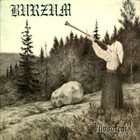 3.46
3.46 |
58 ratings

Phonebook Eater
9/10
"Filosofem" is a milestone album for Black Metal, and its influence is noticeable in many acts today.
The follow up to “Hvis Lyset Tar Oss” is another masterpiece on behalf of Burzum, at this point one of the best Black Metal artists of all time. “Filosofem” is not quite as praised as the previous LP, which is a landmark album for Metal music in general; however, “Filosofem” is still considered another Black Metal classic and an essential release for fans of the genre. This album, the last one before the imprisonment of Varg, is one of the biggest stones that supports the castle.
Again, I will say that Varg Vikernes’ actions and philosophical believes will not be mentioned in this review, because of course they don’t relate directly to the music, not even to some of the lyrics, which are more focused on isolation, desperation, pain, darkness, and admittedly, evil, mentioned in more than a few spots. This however is not a good reason to relate it to something like Satanism or being anti-religious in any way. Filosofem, in fact, means Philosopheme in English, proving how Varg is much more than what he shows to be.
The album’s production is famously raw and lo-fi: Varg, for his guitars, didn’t even use an amplifier, instead he decided to plug them in his brother’s stereo, and record them with again the cheapest equipment he could find. This shows how passionate and determined Vikernes was in attempting to do something quite abnormal, unsettling, and anti-aesthetic. The abrasive instruments, meaning the guitars and drums, at all times, like in the previous album, are accompanied by cold, enigmatic synth sounds that give the music an arcane and surreal imprint. It seems like in “Filosofem” however the keys are much more used overall, and the dedication to Ambient/non Black Metal pieces are much more than in “Hvis Lyst Tar Oss”. But the Metal moments are priceless, hypnotic, and especially dark; in all of it’s distorted fuzziness, “Filosofem” finds unquestionable beauty even in its ugliest places.
Burzum, being the most important artist of Atmospheric Black Metal ( “Hvis Lyset Tar Oss” being the absolute zenith of such genre), continues on with his vision with “Filosofem”: he concentrates almost entirely on creating a dark, haunting, and thought-provoking atmosphere rather than writing memorable songs with catchy riffs. But if in the 1994 release those forty five minutes seemed short and compressed, this 1996 release is the opposite, stretched out to almost 70 minutes, almost forty of which intensively atmospheric, giving to the LP a feeling of completeness by the overwhelmed listener.
The album starts off with the track “Burzum”, a perfect example of a typical song by the artist: repetitive riffs, subtle keyboards, shrieked vocals, and the unforgettable production. Same thing goes with “Jesus’ Death” and “Beholding The Daughters Of Firmament”, although this last track is much slower, much more melodic, eloquent and memorable, surprisingly enough. The more atmospheric part of the album (the point where the drums are no longer heard) starts with “Decrepitude 1”, a Black Metal song with no beats, a song suspended in air, giving an extremely gloomy atmosphere that is however one of the most fascinating ones of the entire album. The twenty five minute Dark Ambient track that follows has been subject to much controversy over the years, because of it’s extreme minimalism and repetition. But once again the aura Varg creates with his keyboards is sublime, and in this particular track I’m dared to say has the best atmosphere on this album. “Decrepitude 2” is the instrumental based entirely on the first part, with some slight modifications overall.
“Filosofem” is nothing less than a Metal masterpiece, that while not having the historical importance of “Hvis Lyset Tar Oss”, still maintains a superb quality, even in the songwriting, and maintains pretty much the same levels as Burzum's official magnum opus.